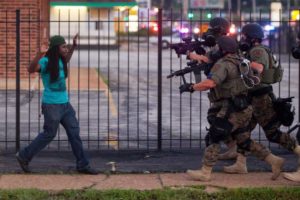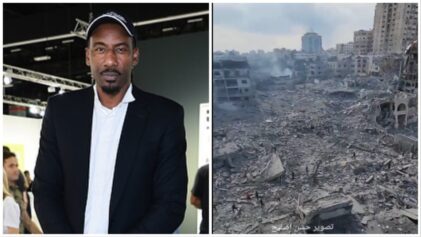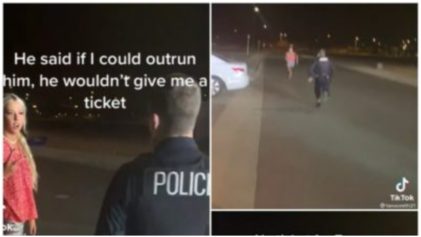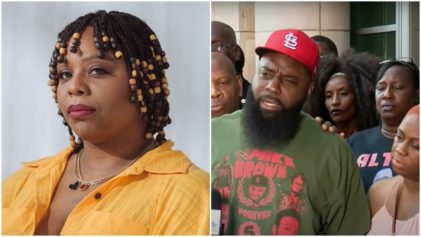
On Aug. 9, 2014, unarmed teenager Michael Brown was fatally shot by Ferguson police officer Darren Wilson. This image provided by KMOV-TV shows investigators inspecting Brown’s body. Tiffany Mitchell—AP
Over the weekend, largely peaceful protests commemorated the one year anniversary of the shooting death of Michael Brown in Ferguson, Mo. On August 9, 2014, Brown, 18, was shot and killed by Ferguson officer Darren Wilson.
Events took place in Ferguson, where one Black man was reportedly shot and critically injured by Ferguson police, and demonstrations were held in other locations such as New York, Denver, Olympia, Washington, Ypsialnti, Michigan, Harvard Square in Cambridge, Massachusetts, and the U.S. Embassy Embassy in London, as the New York Times reported. Further, hundreds attended a rally at Waller County Jail in Hempstead, Texas, where a Black woman named Sandra Bland died following a traffic stop in July.
Family and friends described Brown—who had graduated from high school weeks before his shooting death and who stood at 6-foot-3 and weighed nearly 300 pounds—as a gentle giant. Brown and a friend were walking down Canfield Drive when Wilson told them to move on the sidewalk, per numerous reports. This led to an argument and confrontation, during which time Wilson shot Brown, claiming he acted in self-defense and that Brown attempted to take his gun. Bystanders said Brown, who was unarmed, held up his hands.

Heavily-armed police advance on a protester on Aug. 11, 2014. Law enforcement’s tactical response, which included military-grade weapons, tanks and SWAT teams, touched off a debate over the militarization of local police forces. Whitney Curtis—The New York Times/Redux
The result was months of protest in Ferguson and in cities around the country. Moreover, the fateful day led to the birth of the #BlackLivesMatter movement and with it, greater scrutiny of the treatment of Black people by the police and in the criminal justice system in general, and heightened awareness of the role of white privilege and white supremacy in American society.
Although a St. Louis County grand jury failed to indict Wilson, who left the force, and the U.S. Department of Justice cleared the officer of wrongdoing, the federal agency issued a damning 102-page report in March. The report identified the racism which permeated the Ferguson police department and court system, citing law enforcement for racial profiling and bias in its police tactics, and a for-profit municipal court system which targeted Black residents for fees and fines. As a result, the city’s manager, police chief and municipal judge, all of whom were white, resigned, all replaced by Black officials in this majority-African American city. Other officials who sent racist emails were dismissed, and as the New York Times reported, the Missouri state legislature enacted legislation limiting the amount of revenue that municipalities can collect from traffic tickets.
In Ferguson on Sunday, hundreds converged at the spot where Brown was killed. According to Time, marchers wore t-shirts with the fallen teen’s likeness, and messages reading, “Hands up! Don’t shoot!” and “Please stop killing us.” Others bore shirts and signs in remembrance of others who were killed by police violence.
Participants observed a four and a half minute moment of silence symbolizing the four and a half hours his body remained in the street after he was killed. Two doves were released at the commemoration, followed by a march led by Brown’s father, Michael Brown, Sr., and a service at a Ferguson church.
The range of voices who were present in Ferguson reflect the varying opinions regarding what has transpired since the tragic death of Michael Brown, and the progress made, or lack thereof.

Tear gas rains down on a woman kneeling in the street with her hands in the air during a demonstration in Ferguson on Aug. 17, 2014. The “hands up, don’t shoot” pose became the defining gesture of the protests. Scott Olson—Getty Images
Brown, who said his family is still grieving, concludes that the heightened awareness of police shootings, and the renewed skepticism from the public when police provide their own accounts of these incidents, represent his son’s legacy.
“They’ve made some good positive steps in the right direction,” said Anthony Gray, lawyer for the Brown family to Reuters. “Ferguson seems to be taking the attitude that they want to do some internal adjustments to kind of meet those community needs.”
“I’m proud of Ferguson because we had the audacity to challenge the system,” said Lamar Haynes, 42, a Ferguson resident who owns a public relations and marketing company. Speaking to USA Today, Haynes said too many Black young people are targeted and killed by police. “This is the epicenter that brought consciousness to society.”
Although a number of reforms have been implemented in Ferguson, including anti-bias training, de-escalation tactics and efforts to recruit and retain officers of color, many Ferguson residents remain wary of the police.
“Every black person I know has a fear of police,” said Andrea Walker, 25, a married mother of two. Walker told Reuters she believes public fear of the police is even worse a year later.
“Our criminal justice system is an abysmal failure,” said Cornel West at Greater St. Mark Family Church, according to USA Today. “Black faces in high places don’t always translate it into justice for poor people.”
Rev. Tommie Pierson, the pastor at Greater St. Mark and a state representative, agreed.
“If we’re going to change the system to work for us, we need to run for office and vote for ourselves,” said Rev. Pierson, as reported in the New York Times. “Protesting is good, but it only brings attention to the problems. Solving the problem requires doing other things.”
Erica Garner, whose father, Eric Garner, was killed by New York City police in a chokehold in July, 2014, said elected officials must be held accountable.
Ms. Garner welcomed the move by Black Lives Matter activists to shut down the campaign rally for presidential candidate Bernie Sanders in Seattle on Saturday. “If he’s not going to talk about our issues, he shouldn’t talk at all.”
As NBC News reported, Marcellus Buckley, a poet who was actively involved in the Ferguson protests, recited a poem he spent “all night” writing.
“To the parents, we know you are standing and standing but not alone. All they want is for their child to come home,” Buckley said. “Honestly Mike-Mike, we’re tired. Not in the sense of fighting for our rights but in the sense of fighting for our lives.”


